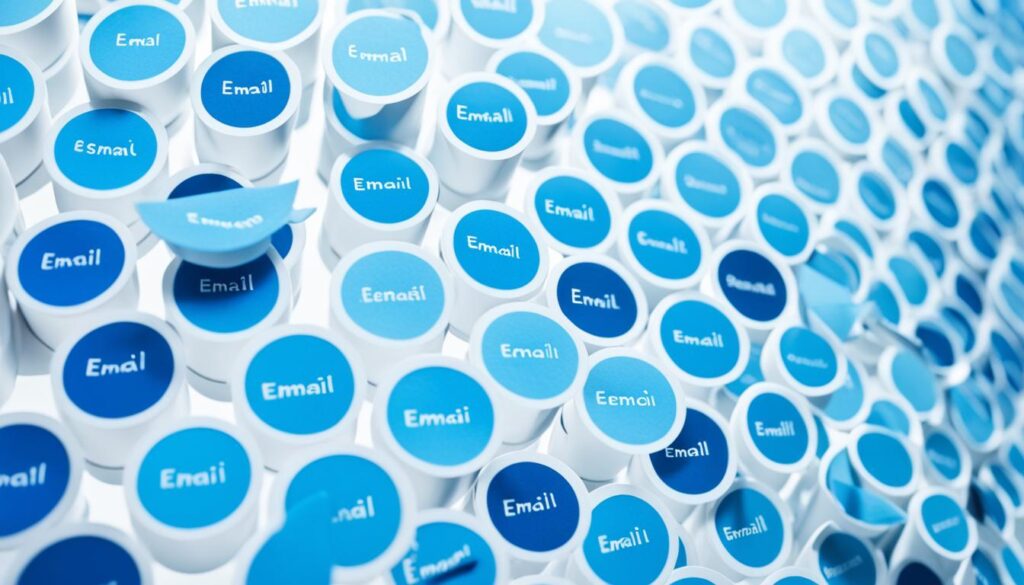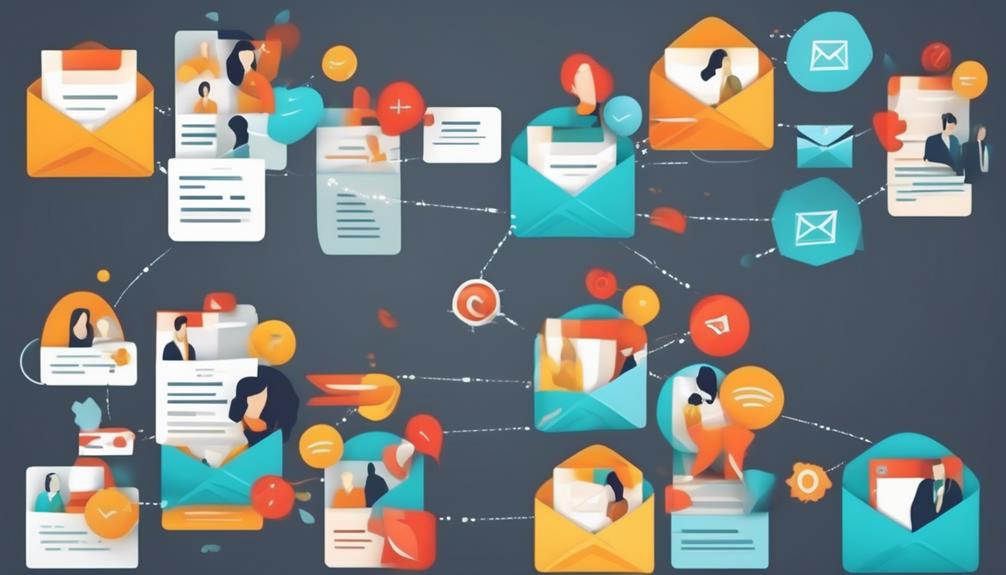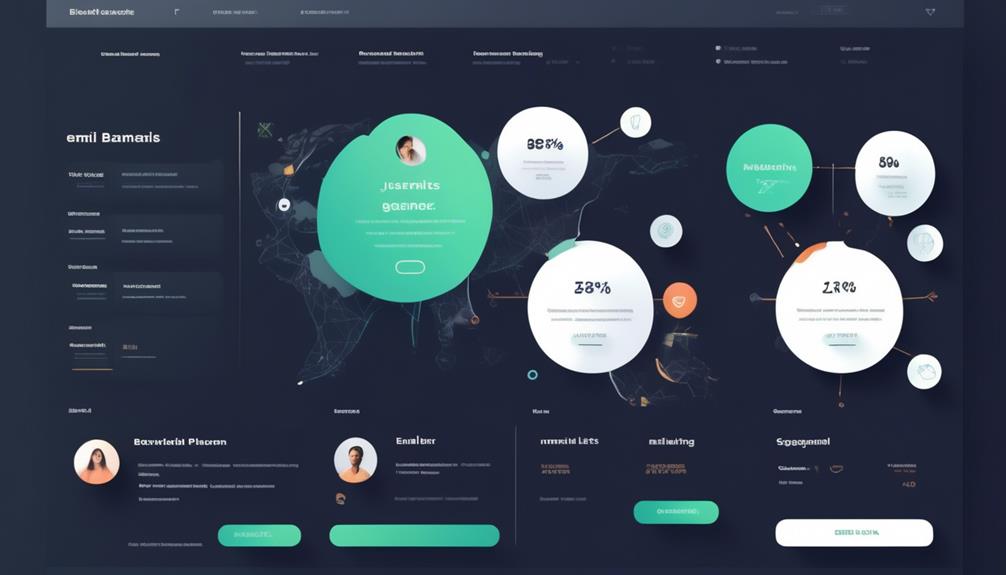Did you know that dividing your email campaigns into segments can increase your email open rates by up to 203%? By targeting your audience with tailored content, you can improve engagement and conversion rates. In a world where people are bombarded with emails daily, standing out is crucial. Email segmentation allows you to personalize your messages and ensure they resonate with your audience’s preferences and needs.
In this article, we will explore the vital new statistics that highlight the importance of segmenting your email campaigns. We’ll delve into the benefits of email segmentation and provide practical strategies on how to effectively implement segmentation techniques. Whether you’re a small business owner or a marketing professional, understanding the power of email segmentation is essential for running successful email marketing campaigns.

Key Takeaways:
- Email segmentation can increase email open rates by up to 203%.
- Segmented campaigns can lead to a 760% increase in revenue
- Segmenting your email campaigns allows for personalized and targeted content delivery.
- Effective email segmentation enhances engagement and conversions.
- Understanding your subscribers’ interests and needs is crucial for successful segmentation.
- Segmentation criteria can include demographics, customer behavior, and engagement with previous emails
- Implementing segmentation strategies can lead to higher ROI for your email marketing efforts.
What are the benefits of email segmentation?
Email segmentation offers several benefits that can significantly improve the performance of your email campaigns. By sending targeted emails to specific segments of your audience, you can increase the open rate and click-through rate of your emails. Personalization and relevance are also enhanced when you tailor your content to each segment, leading to higher conversion rates. Additionally, segmenting your email list can help reduce unsubscribe rates as subscribers receive content that is more aligned with their interests. Ultimately, these benefits contribute to an enhanced return on investment (ROI) for your email marketing efforts.
Increased open rate and click-through rate
By segmenting your email list and delivering targeted content, you can capture the attention of your subscribers more effectively. This leads to increased open rates as subscribers are more likely to engage with emails that are relevant to their needs and preferences. Furthermore, higher click-through rates can be achieved when you provide personalized and enticing content to each segment.
Improved personalization and relevance
Email segmentation allows you to deliver content that is tailored to the specific interests and preferences of each segment. This level of personalization enhances the relevance of your emails, making them more impactful and engaging for your subscribers. By providing content that resonates with their needs, you can foster a stronger connection and increase their loyalty and engagement.
Higher conversion rates
Segmented email campaigns have been proven to generate higher conversion rates compared to generic email blasts. By delivering targeted content to specific segments, you are able to address their pain points, showcase relevant solutions, and drive them towards taking desired actions. This personalized approach increases the likelihood of converting subscribers into customers, resulting in higher conversion rates and improved ROI.
Reduced unsubscribe rates
When you segment your email list and deliver content that is aligned with the interests of each segment, subscribers are less likely to unsubscribe. By providing them with valuable and relevant information, you can nurture their engagement and maintain their interest over time. This helps to reduce unsubscribe rates and retain a larger, more engaged audience.
Enhanced ROI
Email segmentation allows you to optimize your email marketing campaigns and achieve a higher return on investment. By tailoring your content to specific segments, you can generate more conversions, increase customer loyalty, and drive revenue growth. The targeted nature of segmented campaigns ensures that your resources are invested in reaching the most receptive audience, maximizing the overall effectiveness and ROI of your email marketing efforts.
| Benefits of Email Segmentation |
|---|
| Increased open rate |
| Higher click-through rate |
| Improved personalization and relevance |
| Higher conversion rates |
| Reduced unsubscribe rates |
| Enhanced ROI |
How to effectively segment your email list?
In this section, we will discuss effective strategies for segmenting your email list. One key approach is to segment your list based on subscriber behavior. By analyzing how subscribers interact with your emails, such as open rates, click-through rates, and past purchase behavior, you can create segments that cater to their specific interests and preferences. This allows you to send targeted emails that are more likely to resonate with each segment, leading to better engagement and conversions.

To segment based on subscriber behavior, you can gather data from your email marketing platform and analyze key metrics. Here are some steps to consider:
- Identify key engagement indicators: Look for indicators of subscriber behavior, such as open rates, click-through rates, and the frequency of interaction with your emails.
- Create segments based on engagement levels: Divide your email list into segments based on subscribers’ engagement level. This can include active, moderately engaged, and inactive segments.
- Utilize past purchase behavior: If you have an e-commerce business, consider segmenting your list based on past purchase behavior. This can include segmenting customers who have made recent purchases, high-value customers, or customers who have not made a purchase in a certain time frame.
- Personalize content for each segment: Once you have identified your segments, customize your email content to cater to the specific interests and preferences of each segment. This can include offering tailored product recommendations or providing exclusive discounts based on past purchase behavior.
Segmenting your email list based on subscriber behavior can significantly improve the effectiveness of your email campaigns. By sending targeted and relevant content to each segment, you can maximize engagement, increase conversions, and ultimately drive better results from your email marketing efforts.

Use demographic segmentation
Demographic segmentation is a highly effective strategy for segmenting your email list. By categorizing your subscribers based on factors such as age, location, or income, you can deliver more personalized content that aligns with their specific demographic characteristics. This targeted approach helps to increase engagement and conversion rates by providing subscribers with relevant and meaningful content.

Implementing demographic segmentation allows you to create segments that resonate with different demographic groups within your audience. By understanding their unique preferences and needs, you can tailor your email campaigns to appeal to each segment. This level of personalization enhances the customer experience and increases the likelihood of conversions.
For example, you can create a segment for subscribers in a specific age range to promote age-related products or services. Alternatively, you can target subscribers in certain locations with localized promotions or events. By leveraging demographic segmentation, you can make a deeper connection with your audience and foster stronger brand loyalty.
Implement segmentation based on engagement levels
Segmenting your email list based on engagement levels is another effective strategy to optimize your email campaigns. By dividing your subscribers into active and inactive groups, you can tailor your messaging to re-engage inactive subscribers and nurture active ones.
For inactive subscribers, you can create a specific segment and design re-engagement campaigns to win them back. These campaigns can include enticing offers, personalized content, or reminders of the value they’ll receive by staying subscribed. By focusing on re-engagement, you can revitalize your relationship with inactive subscribers and potentially convert them into active customers once again.
Active subscribers, on the other hand, can be segmented based on their level of engagement. This allows you to send targeted emails that recognize their existing interaction with your brand. Whether it’s rewarding loyal customers with exclusive offers or providing additional resources to avid readers, segmenting based on engagement levels allows you to nurture these valuable relationships and increase overall engagement.
Create segments according to past purchase history
Segmenting your email list based on past purchase history enables you to leverage customer buying behavior to deliver more relevant and personalized content. By analyzing the purchase patterns of your subscribers, you can create segments that align with their specific interests and preferences.
For example, if you have an online clothing store, you can create segments based on the type of clothing or accessories that customers have purchased in the past. This allows you to send targeted emails showcasing new arrivals or promotions for similar products. By tailoring your emails to each customer’s past purchase history, you can increase the likelihood of them making repeat purchases and foster customer loyalty.
Segmenting based on purchase history also enables you to provide personalized product recommendations, cross-selling opportunities, and customized offers that align with each customer’s preferences. This level of personalization enhances the customer experience and can significantly impact your bottom line.
Utilize list segmentation for inactive subscribers
List segmentation specifically for inactive subscribers allows you to craft targeted email campaigns to re-engage them. By identifying subscribers who have shown little to no engagement with your emails, you can implement a list segmentation strategy to recapture their interest and encourage them to become active again.
When segmenting inactive subscribers, it’s essential to understand the reasons behind their inactivity. By analyzing their interaction with your emails, you can gain insights into their preferences or pain points that may have led to their disengagement. Utilize this information to create segments with tailored messages, offers, or incentives that resonate with their specific needs.
Re-engagement campaigns targeted at inactive subscribers can include exclusive discounts, reminders of the benefits they’ll receive by staying subscribed, or updates on new features or improvements. Implementing list segmentation for inactive subscribers allows you to optimize your email marketing efforts, increase the chances of re-engagement, and prevent valuable subscribers from slipping away.

What are the key email marketing statistics related to segmentation?
In this section, we will explore the latest email marketing statistics highlighting segmentation’s impact and benefits in email campaigns. Segmentation is crucial in enhancing the effectiveness and ROI of your email marketing efforts. Let’s delve into the key statistics and insights that demonstrate the power of segmentation.
Impact of segmentation on email marketing campaigns
Segmentation has a profound impact on email marketing campaigns, improving various performance metrics and driving better engagement. Consider the following statistics:
- Segmented campaigns have been observed to generate 760% increase in email revenue.
- Email open rates improve by an average of 14.32% when utilizing segmented lists.
- Click-through rates soar to 100.95% higher for segmented campaigns compared to non-segmented ones.
- List segmentation contributes to a 39% higher email open rate and a 28% lower unsubscribe rate.
Segmentation strategies for higher conversion rates
Implementing effective segmentation strategies can significantly boost conversion rates and overall campaign performance. Consider the following strategies:
- Behavioral segmentation: Tailoring emails based on subscriber behavior and preferences can lead to a 76% increase in email revenue.
- Demographic segmentation: Customizing emails according to demographic characteristics, such as age, location, or income, can result in a 29% increase in email open rates.
- Purchase history segmentation: Segmenting lists based on past purchase behavior can generate a 122% increase in revenue per email.
- Inactivity segmentation: Re-engaging inactive subscribers through targeted campaigns can lead to a 33% increase in click-through rates.
Email marketing metrics influenced by segmentation
Segmentation plays a vital role in shaping various email marketing metrics, offering insights into the effectiveness and performance of your campaigns. Consider the following metrics:
- Deliverability: Segmented campaigns achieve 14.31% higher deliverability rates compared to non-segmented ones.
- Engagement: Segmented emails generate a 233% higher engagement rate compared to non-segmented ones.
- ROI: Businesses experience an average return on investment of $42 for every $1 spent on email marketing, thanks to effective segmentation.
Case studies demonstrating the power of list segmentation
“By segmenting our email list and personalizing our content, we saw a 98% increase in email revenue within three months.” – Company A
“Implementing behavioral segmentation helped us achieve a 60% higher click-through rate and a 40% increase in conversion rates.” – Company B
These case studies demonstrate the tangible benefits and success achieved through list segmentation. By utilizing targeted segmentation strategies, businesses have witnessed significant improvements in key metrics and revenue generation.
Projected email segmentation trends for 2024
As we look ahead to the future, certain trends are expected to shape the landscape of email segmentation in 2024. These trends include:
- AI-powered segmentation: Artificial intelligence will play a larger role in automating and optimizing segmentation processes for more accurate targeting and personalization.
- Micro-segmentation: Marketers will focus on creating even smaller and more granular segments to maximize relevance and engagement.
- Dynamic segmentation: Real-time data and user behavior will be utilized to dynamically adjust segment criteria and deliver personalized content.
These projected trends highlight the evolving nature of email segmentation and its continued importance in driving successful email marketing campaigns in the years to come.
The Impact of Email Segmentation

| Email Marketing Statistics | Statistics |
|---|---|
| Increased Email Revenue | 760% increase in revenue with segmented campaigns. |
| Higher Open Rates | 14.32% increase in open rates with segmented lists. |
| Improved Click-Through Rates | 100.95% higher click-through rates for segmented campaigns. |
| Lower Unsubscribe Rates | 28% lower unsubscribe rate with list segmentation. |
| Customized Content | 76% increase in revenue with behavioral segmentation. |
| Targeted Demographics | 29% increase in open rates with demographic segmentation. |
| Personalized Offers | 122% increase in revenue per email with purchase history segmentation. |
| Re-Engagement Success | 33% increase in click-through rates with inactivity segmentation. |
| Higher Deliverability | 14.31% higher deliverability rates with segmented campaigns. |
| Enhanced Engagement | 233% higher engagement rates with segmented emails. |
| Impressive ROI | Average $42 return on investment for every $1 spent on email marketing. |
Why is segmentation crucial for successful email marketing campaigns?
In order to achieve success in email marketing campaigns, segmentation plays a critical role. By effectively segmenting your email list, you can enhance targeting and personalization, ensuring that your emails are relevant to each subscriber. This leads to improved email content relevance and increases the chances of engagement and interaction with your emails. Furthermore, segmentation contributes to the increased longevity and loyalty of subscribers, as they receive content tailored to their interests. Additionally, segmentation enables optimized automation and drip campaigns, allowing for more personalized and timely communication with your audience.

| Benefits of Segmentation |
|---|
| Enhanced Targeting |
| Personalization |
| Improved Content Relevance |
| Maximized Engagement and Interaction |
| Increased Longevity and Loyalty of Subscribers |
| Optimized Automation and Drip Campaigns |
What are the best practices for implementing email segmentation strategies?
In order to maximize the effectiveness of email segmentation, it is important to follow best practices that ensure targeted and personalized communication with your subscribers. Implementing these strategies will help you deliver highly relevant content and optimize your email marketing campaigns. Let’s explore the key best practices for email segmentation:
Create Custom Segments Based on Unique Subscriber Attributes
One of the fundamental best practices for email segmentation is to create custom segments based on unique subscriber attributes. By collecting and analyzing data such as demographic information, past purchase behavior, and engagement levels, you can categorize your subscribers into specific groups. This allows you to tailor your email content and offers to each segment’s preferences and needs. For example, you can create segments based on age, location, or industry, or even customize your segments based on specific product preferences or interests.
Utilize Dynamic Content for Personalized Email Campaigns
Dynamic content is a powerful tool that enables you to personalize your email campaigns based on the unique characteristics and preferences of your subscribers. By utilizing dynamic content, you can serve different variations of your email content to different segments of your audience. Whether it’s showcasing specific product recommendations, personalized offers, or localized content, dynamic content helps create a hyper-relevant and engaging email experience.

Test and Refine Segment Criteria for Continuous Enhancement
Segmentation is an ongoing process that requires continuous testing and refinement. It’s essential to analyze the performance of your segments and optimize their criteria based on key metrics such as open rates, click-through rates, and conversions. By regularly testing and refining segment criteria, you can ensure that you are targeting the right audience with the most relevant content. This iterative approach helps you improve the effectiveness of your segments over time.
Integrate Segmentation with Marketing Automation Tools
Integrating your email segmentation strategy with marketing automation tools can significantly streamline your efforts. Marketing automation platforms allow you to automate the segmentation process, ensuring that your subscribers are dynamically placed into the appropriate segments based on their behavior and attributes. This integration also enables you to trigger personalized email campaigns and automated workflows based on specific segment criteria, resulting in more efficient and effective email marketing.
Leverage Segmentation for Effective Re-engagement Campaigns
Segmentation plays a crucial role in re-engaging inactive subscribers. By creating segments specifically for inactive users, you can design targeted re-engagement campaigns to win them back. Customize your re-engagement emails based on their previous interactions with your brand or offer exclusive promotions to incentivize their return. Leveraging segmentation for re-engagement campaigns helps reignite interest and encourages subscribers to become active and engaged once again.
Implementing these best practices will enable you to harness the power of email segmentation and create impactful, personalized, and targeted campaigns. By continuously refining your segments, utilizing dynamic content, integrating with marketing automation tools, and leveraging segmentation for re-engagement, you can optimize your email marketing strategy and drive better results.
Conclusion
Segmenting your email campaigns is essential for achieving success in email marketing. The new statistics presented in this article clearly highlight the importance and numerous benefits of email segmentation. By dividing your email list into smaller, targeted segments based on subscriber behavior, demographic data, engagement levels, and purchase history, you can deliver personalized and relevant content to your subscribers.
Implementing the best practices for email segmentation ensures that your campaigns are more targeted, engaging, and effective. Not only does segmentation result in increased open rates, click-through rates, and conversion rates, it also helps reduce unsubscribe rates and enhances your overall return on investment (ROI). By leveraging the power of segmentation, you can optimize your email marketing strategies and achieve better results.
Segmenting your email campaigns allows you to deliver content that resonates with your audience, making them more likely to engage with your emails. It enables you to create custom segments based on unique subscriber attributes, utilize dynamic content for personalized email campaigns, and test and refine segment criteria to continuously improve your strategy. Additionally, integrating segmentation with marketing automation tools streamlines your efforts and enables more efficient campaign management.
In conclusion, adopting email segmentation as part of your email marketing strategy is crucial for maximizing the effectiveness of your campaigns. By segmenting your email list and tailoring your content to specific audience segments, you can create more targeted and personalized communication that drives engagement, conversions, and long-term loyalty from your subscribers.
FAQ
What are the benefits of email segmentation?
Email segmentation offers several benefits, including increased open rates and click-through rates, improved personalization and relevance, higher conversion rates, reduced unsubscribe rates, and enhanced ROI.
How to effectively segment your email list?
You can segment your email list based on subscriber behavior, such as open rates, click-through rates, and past purchase behavior. This helps you create targeted segments that cater to specific interests and preferences.
How to use demographic segmentation?
Demographic segmentation involves categorizing subscribers based on factors like age, location, or income. This allows you to deliver more personalized content based on their unique demographic characteristics.
How to segment based on engagement levels?
By dividing your subscribers into active and inactive groups, you can target each segment with appropriate messaging to re-engage inactive subscribers or nurture active ones.
How to create segments based on past purchase history?
Segmenting your list based on past purchase behavior enables you to tailor your emails to each customer’s buying habits, ensuring that they receive relevant content related to their previous purchases.
How to utilize list segmentation for inactive subscribers?
List segmentation can be used specifically for inactive subscribers to craft re-engagement or win-back campaigns, helping to revive their interest and increase engagement.
What are the key email marketing statistics related to segmentation?
Key statistics include the impact of segmentation on email marketing campaigns, strategies for higher conversion rates, metrics influenced by segmentation, case studies demonstrating the power of list segmentation, and projected trends for 2024.
Why is segmentation crucial for successful email marketing campaigns?
Segmentation is crucial because it enables enhanced targeting and personalization, improved email content relevance, maximized engagement and interaction, increased longevity and loyalty of subscribers, and optimized automation and drip campaigns.
What are the best practices for implementing email segmentation strategies?
Best practices include creating custom segments based on unique subscriber attributes, utilizing dynamic content for personalized email campaigns, testing and refining segment criteria for continuous enhancement, integrating segmentation with marketing automation tools, and leveraging segmentation for effective re-engagement campaigns.










